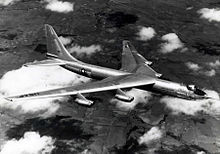Convair YB-60
| Convair YB-60 | |
|---|---|
 Aerial view of a YB-60 on the ground |
|
| Type: | Prototype of a strategic bomber |
| Design country: | |
| Manufacturer: | |
| First flight: |
April 18, 1952 |
| Commissioning: |
Flight tests ended in 1953 |
| Production time: |
was never mass-produced |
| Number of pieces: |
2 |
The Convair YB-60 was the prototype of a strategic long-range bomber for the United States Air Force in the early 1950s. The program was canceled in favor of Boeing's YB-52 ; the testing continued until January 20, 1953. The YB-60 was the largest aircraft of its time.
history
On August 25, 1950, Convair submitted a proposal for a revised version of the Convair B-36 to the US Air Force (USAF) , although no corresponding order had been placed; The reason for this advance was to stay in the market after Boeing had delivered a very successful bomber to the USAF with the jet-powered B-47 . At this point in time, the B-36 was already technically obsolete, and Convair wanted to respond to the new technical features introduced by the B-47 and develop the B-36 further. The US Air Force showed interest, so that on March 15, 1951, the conversion of two partially completed B-36s to YB-60 and B-60 (second prototype) was approved.
The YB-60 was very similar to its basic B-36 pattern. The fuselage of the YB-60 was 72 percent identical to that of the B-36. This extensive re-use of elements of the B-36 initially reduced the costs of the YB-60. However, this also meant that already outdated basic structures of a piston engine aircraft were found in the new model. The main difference between the YB-60 and its original design was the new swept-back wing, from which eight Pratt & Whitney J57 P-3 jet engines were now attached. As with the YB-52, they were mounted in pairs in four nacelles under the wings. All features of the piston engine design have been removed as far as possible without a complete redesign. The tail surfaces were also swept and a sensor antenna was attached to the bow. The 15-man crew of the B-36 could be reduced to ten men.
The Convair YB-60 with serial number 49-2676 made its maiden flight on April 18, 1952, three days after the maiden flight of the Boeing 'competing' prototype YB-52. It was flown by Beryl Erickson. It quickly became clear that the YB-60 was inferior to the YB-52. In this unofficial competition, Convair's design was slower and had a shorter range. There were also problems with the handling of the machine, since the control elements were designed for the slower flight speeds of a piston engine aircraft. At lower acquisition costs, the YB-60 could carry a larger weapon load, but the design ultimately did not convince the Air Force, as the YB-52 with its overall higher performance, the technically convincing, more modern overall concept and the assumed higher potential for further development prevailed and consequently of was appointed to the US Air Force in December 1952.
The flight tests of the YB-60 continued until January 1953, the second prototype of the B-60 under construction was 95% completed. He showed other changes. The front of the fuselage was made more aerodynamic, so that the machine would have reached a higher top speed.
Although the YB-60 program was canceled in 1952 and flight testing ended in 1953, both machines (including the almost completed second prototype) were officially handed over to the US Air Force in 1954 in order to meet the conditions of the preliminary contract. However, the Air Force no longer used the machines and both prototypes were scrapped in the same year.
Ultimately, the YB-60 shows the rapid development of aviation technology in the 1950s. The revised version of an old machine could not keep up with a completely new design.
Technical specifications

| Parameter | Data |
|---|---|
| crew | 10 |
| length | 52.10 m |
| span | 62.80 m |
| height | 18.40 m |
| Wing area | 487 m² |
| Wing extension | 8.10 |
| Wing loading |
|
| Empty mass | 69,407 kg |
| Max. Takeoff mass | 185,973 kg |
| Top speed | 818 km / h |
| Max. Altitude | approx. 16,200 m |
| Rate of climb | 5.38 m / s |
| Use radius | approx. 4,700 km |
| Range | approx. 13,000 km |
| Engines | eight Pratt & Whitney J57-P-3 - jet engines |
| Thrust | 8 × 38.71 kN |
| Thrust-to-weight ratio |
|
| Armament |
|
Web links
swell
- ↑ a b Erik Simonsen: Boeing's YB-52 beat out Convair's YB-60 - and continues to serve. Boeing, accessed September 5, 2017 .



